初中英语动词时态归纳总结对照表
- 格式:doc
- 大小:111.00 KB
- 文档页数:41
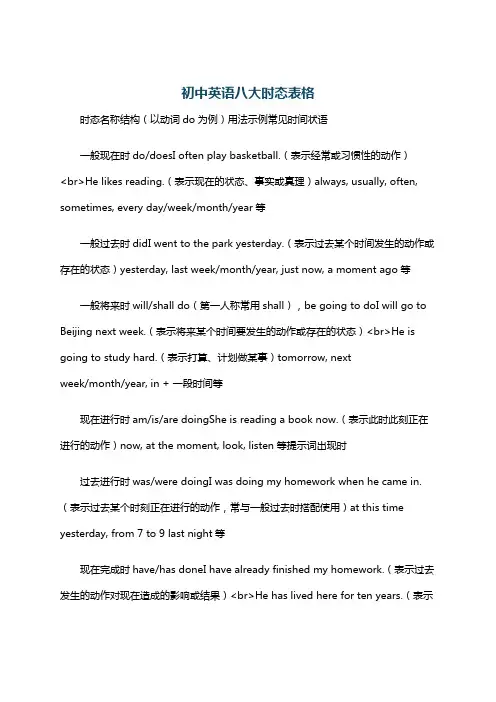
初中英语八大时态表格时态名称结构(以动词do为例)用法示例常见时间状语一般现在时do/doesI often play basketball.(表示经常或习惯性的动作)<br>He likes reading.(表示现在的状态、事实或真理)always, usually, often, sometimes, every day/week/month/year等一般过去时didI went to the park yesterday.(表示过去某个时间发生的动作或存在的状态)yesterday, last week/month/year, just now, a moment ago等一般将来时will/shall do(第一人称常用shall),be going to doI will go to Beijing next week.(表示将来某个时间要发生的动作或存在的状态)<br>He is going to study hard.(表示打算、计划做某事)tomorrow, nextweek/month/year, in + 一段时间等现在进行时am/is/are doingShe is reading a book now.(表示此时此刻正在进行的动作)now, at the moment, look, listen等提示词出现时过去进行时was/were doingI was doing my homework when he came in.(表示过去某个时刻正在进行的动作,常与一般过去时搭配使用)at this time yesterday, from 7 to 9 last night等现在完成时have/has doneI have already finished my homework.(表示过去发生的动作对现在造成的影响或结果)<br>He has lived here for ten years.(表示过去已经开始,持续到现在的动作或状态)already, yet, just, ever, never, for + 时间段, since + 时间点等过去完成时had doneWhen I got to the station, the train had already left.(表示在过去某个时间或动作之前已经发生或完成的动作,即“过去的过去”)by the end of last year, before + 一般过去时的句子等将来进行时will be doingI will be having a meeting at this time tomorrow.(表示将来某个时刻或时间段正在进行的动作)at this time tomorrow等。
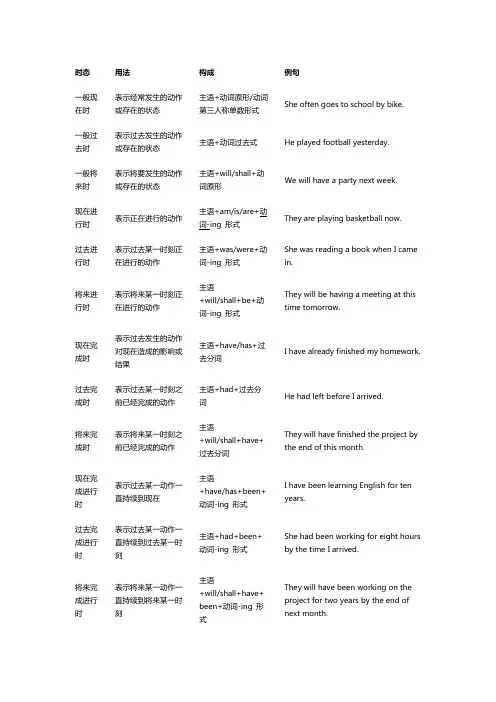
一般现在时表示经常发生的动作或存在的状态主语+动词原形/动词第三人称单数形式She often goes to school by bike.一般过去时表示过去发生的动作或存在的状态主语+动词过去式He played football yesterday.一般将来时表示将要发生的动作或存在的状态主语+will/shall+动词原形We will have a party next week.现在进行时表示正在进行的动作主语+am/is/are+动词-ing 形式They are playing basketball now.过去进行时表示过去某一时刻正在进行的动作主语+was/were+动词-ing 形式She was reading a book when I camein.将来进行时表示将来某一时刻正在进行的动作主语+will/shall+be+动词-ing 形式They will be having a meeting at thistime tomorrow.现在完成时表示过去发生的动作对现在造成的影响或结果主语+have/has+过去分词I have already finished my homework.过去完成时表示过去某一时刻之前已经完成的动作主语+had+过去分词He had left before I arrived.将来完成时表示将来某一时刻之前已经完成的动作主语+will/shall+have+过去分词They will have finished the project bythe end of this month.现在完成进行时表示过去某一动作一直持续到现在主语+have/has+been+动词-ing 形式I have been learning English for tenyears.过去完成进行时表示过去某一动作一直持续到过去某一时刻主语+had+been+动词-ing 形式She had been working for eight hoursby the time I arrived.将来完成进行时表示将来某一动作一直持续到将来某一时刻主语+will/shall+have+been+动词-ing 形式They will have been working on theproject for two years by the end ofnext month.过去将来时表示过去某一时刻之后将要发生的动作主语+would/should+动词原形He said he would come back the nextday.过去将来进行时表示过去某一时刻之后将要进行的动作主语+would/should+be+动词-ing 形式She said she would be working on theproject at that time.过去将来完成时表示过去某一时刻之后将要完成的动作主语+would/should+have+过去分词He said he would have finished thework by the end of the week.。
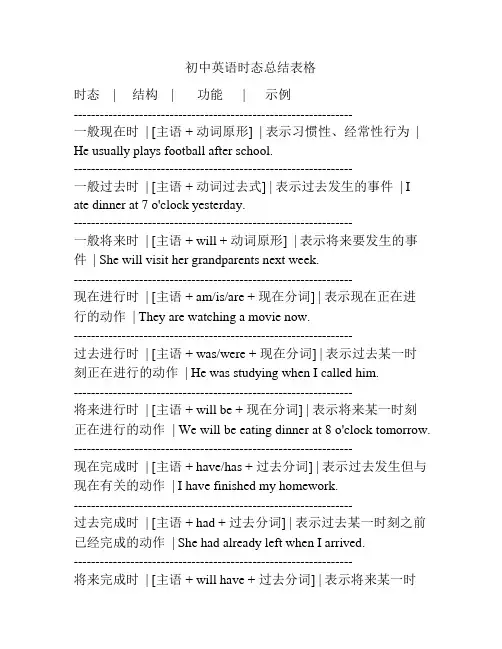
初中英语时态总结表格时态 | 结构 | 功能 | 示例----------------------------------------------------------------一般现在时 | [主语 + 动词原形] | 表示习惯性、经常性行为 | He usually plays football after school.----------------------------------------------------------------一般过去时 | [主语 + 动词过去式] | 表示过去发生的事件 | I ate dinner at 7 o'clock yesterday.----------------------------------------------------------------一般将来时 | [主语 + will + 动词原形] | 表示将来要发生的事件 | She will visit her grandparents next week.----------------------------------------------------------------现在进行时 | [主语 + am/is/are + 现在分词] | 表示现在正在进行的动作 | They are watching a movie now.----------------------------------------------------------------过去进行时 | [主语 + was/were + 现在分词] | 表示过去某一时刻正在进行的动作 | He was studying when I called him.----------------------------------------------------------------将来进行时 | [主语 + will be + 现在分词] | 表示将来某一时刻正在进行的动作 | We will be eating dinner at 8 o'clock tomorrow. ----------------------------------------------------------------现在完成时 | [主语 + have/has + 过去分词] | 表示过去发生但与现在有关的动作 | I have finished my homework.----------------------------------------------------------------过去完成时 | [主语 + had + 过去分词] | 表示过去某一时刻之前已经完成的动作 | She had already left when I arrived.----------------------------------------------------------------将来完成时 | [主语 + will have + 过去分词] | 表示将来某一时刻之前已经完成的动作 | By this time next year, we will have graduated from high school.----------------------------------------------------------------情态动词 | [情态动词 + 动词原形] | 表示能力、意愿、推测等 | She can swim very well.----------------------------------------------------------------。
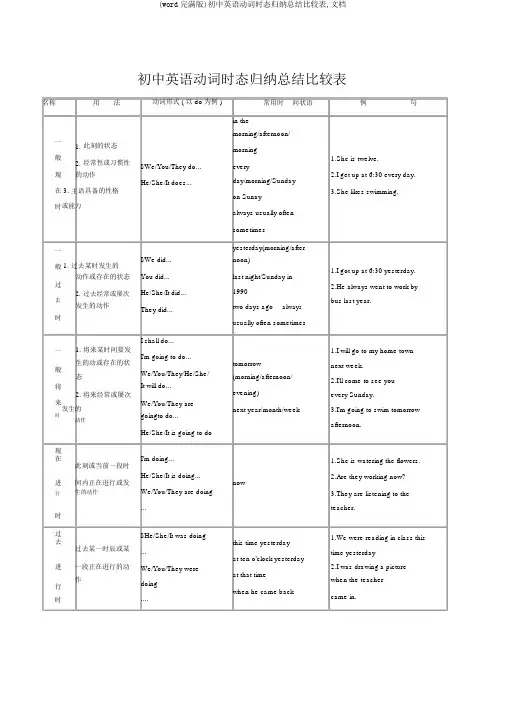
初中英语动词时态归纳总结比较表名称用法一1.此刻的状态般2.经常性或习惯性现的动作在3. 主语具备的性格时或能力一般1. 过去某时发生的动作或存在的状态过2.过去经常或屡次去发生的动作时一 1. 将来某时间要发生的动或存在的状般态将2. 将来经常或屡次来发生的时动作现在此刻或当前一段时进间内正在进行或发行生的动作时过去过去某一时辰或某进一段正在进行的动行作时动词形式 ( 以 do 为例 )I/We/You/They do...He/She/It does...I/We did...You did...He/She/It did...They did...I shall do...I'm going to do...We/You/They/He/She/It will do...We/You/They aregoingto do...He/She/It is going to doI'm doing...He/She/It is doing...We/You/They are doing...I/He/She/It was doing...We/You/They weredoing....常用时间状语in themorning/afternoon/morningeveryday/morning/Sundayon Sunayalways usually oftensometimesyesterday(morning/afternoon)last night/Sunday in1990two days ago alwaysusually often sometimestomorrow(morning/afternoon/evening)next year/month/weeknowthis time yesterdayat ten o'clock yesterdayat that timewhen he came back例句1.She is twelve.2.I get up at 6:30 every day.3.She likes swimming.1.I got up at 6:30 yesterday.2.He always went to work bybus last year.1.I will go to my home townnext week.2.I'll come to see youevery Sunday.3.I'm going to swim tomorrowafternoon.1.She is watering the flowers.2.Are they working now?3.They are listening to theteacher.1.We were reading in class thistime yesterday2.I was drawing a picturewhen the teachercame in.1.过去发生或已经现完成的某一动作对在此刻造成的影响或完结果成2. 表示过去已经开始并连续到此刻的时动作或状态过去过去某一时间前已完经发后的动作或状成态时现在此刻以前的一段时完间里素来进行的动成作 , 这个运作可能进仍在进行 , 也可能连续进行下去行时He/She/It has done...We/You/They havedone...I/We/You/He/She/Ithad done .I/We/You/They havebeen doing .He/She/It has beendoing .1.I've already posted thealready just before neletter.ver2.We have known each otherfor three yearsfor ten years.since 19903.They lived here since 1997.this morning4.Have you ever been tothese daysBeijing?1.I had learned 2000 words byby the end ofthe end of last term.when+一般过去时2.When I got out,the bus hadbefore+一般过去时already left.1.I have been skating for fivesince nine o’ clock hours.for five hours 2.She has been skating sincenine o’ clock..初中英语时态专项练习1、一般此刻时。
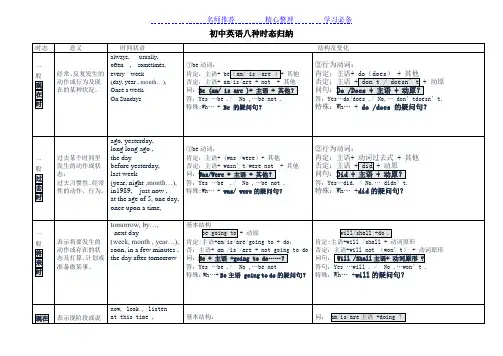
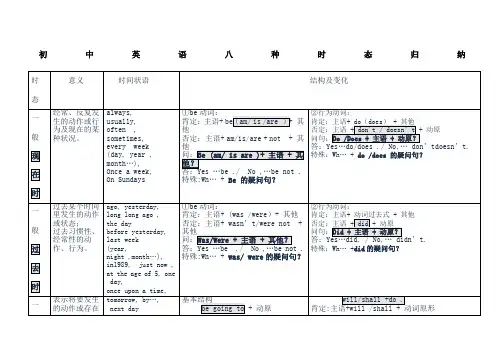
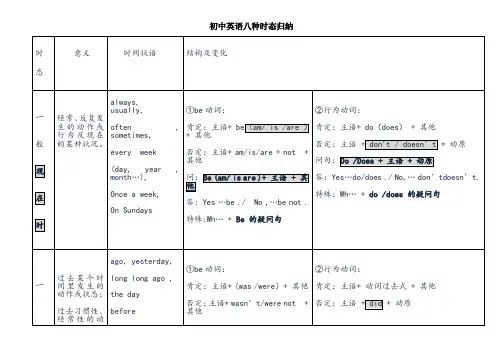

初中时态语态总结表格初中时态语态总结表格动词形式一般现在时一般过去时一般将来时完成时态进行时态被动语态一般形式 V原形+s/es V-ed will/shall+V原形have/has+V过去分词 am/is/are+V-ing am/is/are+V过去分词例句 She plays basketball. He studied English yesterday. I will go to the beach tomorrow. They have finished their homework. I am watching TV now. The book was written by Mark.时态解释表示现在发生的动作或状态。
表示过去发生的动作或状态。
表示将来发生的动作或状态。
表示过去发生并一直延续到现在的动作或状态。
表示说话时正在进行的动作或状态。
表示动作的承受者。
一般性使用主语+动词主语+动词ed 主语+will/shall+动词主语+have/has+动词ed 主语+am/is/are+动词ing 主语+am/is/are+动词过去分词一般疑问句助动词(do/does)/be动词(is/am/are)+主语+动词助动词(did)/be动词(was/were)+主语+动词助动词(will/shall)/be动词(is/am/are)+主语+动词助动词(have/has)/be动词(is/am/are)+主语+动词ed 助动词(am/is/are)/be动词(is/am/are)+主语+ 动词ing 助动词(am/is/are)/be动词(is/am/are)+主语+动词过去分词特殊疑问句疑问词+助动词(do/does)/be动词(is/am/are)+主语+动词疑问词+助动词(did)/be动词(was/were)+主语+动词疑问词+助动词(will/shall)/be 动词(is/am/are)+主语+动词疑问词+助动词(have/has)/be动词(is/am/are)+主语+动词ed 疑问词+助动词(am/is/are)/be动词(is/am/are)+主语+ 动词ing 疑问词+助动词(am/is/are)/be动词(is/am/are)+主语+动词过去分词否定句主语+助动词(do not/does not)/be动词(is/am/are not)+动词主语+助动词(did not)/be动词(was/were not)+动词主语+助动词(will/shall not)/be动词(is/am/are not)+动词主语+助动词(have/has not)/be 动词(is/am/are not)+动词ed 主语+助动词(am not/is not/are not)/be动词(is/am/are not)+动词ing 主语+助动词(am not/is not/are not)/be动词(is/am/are not)+动词过去分词情态动词主语+情态动词+动词原形主语+情态动词+动词原形主语+will/shall+情态动词+动词原形主语+have/has+情态动词+动词原形主语+am/is/are+情态动词+ 动词ing 主语+am/is/are+情态动词+动词过去分词现在进行时主语+am/is/are+V-ing 主语+was/were+V-ing 主语+will/shall+be+V-ing 主语+have/has+been+V-ing - -过去进行时主语+was/were+V-ing -- - - -将来进行时主语+will/shall+be+V-ing -- - - -完成进行时主语+have/has+been+V-ing 主语+had+been+V-ing - -- -被动语态主语+am/is/are+V过去分词主语+was/were+V过去分词主语+will/shall+be+V过去分词主语+have/has+been+V过去分词主语+am/is/are+being+V过去分词主语+am/is/are+V过去分词。
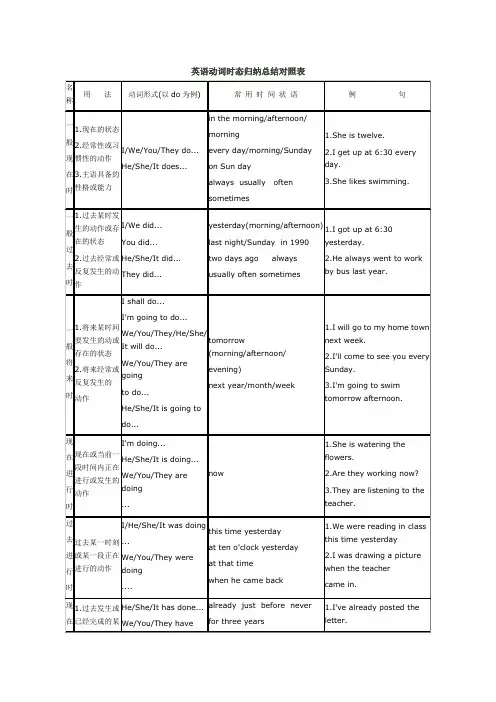
英语动词时态归纳总结对照表英语时态专项练习1、一般现在时。
通常用“usually, often, every day, sometimes”。
一般现在时基本用法介绍一、一般现在时的功能1.表示事物或人物的特征、状态。
如:The sky is blue.天空是蓝色的。
2.表示经常性或习惯性的动作。
如:I get up at six every day.我每天六点起床。
3.表示客观现实。
如:The earth goes around the sun.地球绕着太阳转。
二、一般现在时的构成:肯定句:1).主语+系动词 be(is, am, are )+名词(形容词,介词短语)2) .其他主语+动词原形+其它第三人称单数+动词-s+其它如:I am a boy.我是一个男孩。
We study English.我们学习英语。
Mary likes Chinese.玛丽喜欢汉语。
三、一般现在时的变化否定句:1)主语+ be (is,am,are)+ not +其它。
如:He is not a worker.他不是工人。
2)其他主语+do not(don’t)动词原形+其它I don't like bread第三人称单数+does not(doesn’t)动词原形+其它He doesn't often play.一般疑问句:1)Be(Is,Are) +主语+其它?如:-Are you a student? -Yes. I am. / No, I'm not.2)Do其他主语+动词原形+其它?Does+第三人称单数+动词原形+其它+?注意:遇I/we—you, my—your, some—any.Does she go to work by bike? - Yes, she does. / No, she doesn't.Do you often play football?- Yes, I do. / No, I don't.特殊疑问句:疑问词+一般疑问句。

初中英语八大时态
一般现在时:am/is/are + 动词原形
一般过去时:was/were + 动词的过去式
现在进行时:am/is/are + 动词的现在分词
过去进行时:was/were + 动词的现在分词
一般将来时:will + 动词原形
过去将来时:助动词would + 动词原形或was/were going to + 动词原形
现在完成时:助动词have/has + 动词的过去分词
过去完成时:助动词had + 动词的过去分词
一般现在时:every day,week,mouth,year,always,usually,often,sometimes,seldom 一般过去时:yesterday,the day,before,yesterday,just,now,ago,last week
现在进行时:now,these days,this week,all the time
过去进行时:at the day,then,this time yesterday,the hole morning
一般将来时:tomorrow,the day after tomorrow,next time,from now on,later (on),soon 过去将来时:the next day,the following week,soon,one day,in a week
现在完成时:already,yet,never,so far,since,before。

初中英语动词时态归纳总结对照表初中英语动词时态归纳总结对照表名称用法动词形式(以do为例) 常用时间状语例句一般现在时1.现在的状态2.经常性或习惯性的动作3.主语具备的性格或能力I/We/You/They do...He/She/It does...in the morning/afternoon/morningevery day/morning/Sundayon Sunayalways usually oftensometimes1.She is twelve.2.I get up at 6:30every day.3.She likesswimming.一般过去时1.过去某时发生的动作或存在的状态2.过去经常或反复发生的动作I/We did...You did...He/She/It did...They did...yesterday(morning/afternoon)last night/Sunday in 1990two days ago alwaysusually often sometimes1.I got up at 6:30yesterday.2.He always went towork by bus lastyear.一般将来时1.将来某时间要发生的动或存在的状态2.将来经常或反复发生的动作I shall do...I'm going to do...We/You/They/He/She/It will do...We/You/They are goingto do...He/She/It is going todo...tomorrow(morning/afternoon/evening)next year/month/week1.I will go to myhome town nextweek.2.I'll come to see youevery Sunday.3.I'm going to swimtomorrow afternoon.现在进行现在或当前一段时间内正在进行或I'm doing...He/She/It is doing...We/You/They are doing...now1.She is watering theflowers.2.Are they workingnow?时发生的动作3.They are listening to the teacher.过去进行时过去某一时刻或某一段正在进行的动作I/He/She/It was doing...We/You/They weredoing....this time yesterdayat ten o'clock yesterdayat that timewhen he came back1.We were reading inclass this timeyesterday2.I was drawing apicture when theteachercame in.现在完成时1.过去发生或已经完成的某一动作对现在造成的影响或结果2.表示过去已经开始并持续到现在的动作或状态He/She/It has done...We/You/They havedone...already just before neverfor three yearssince 1990this morningthese days1.I've already postedthe letter.2.We have knowneach other for tenyears.3.They lived heresince 1997.4.Have you everbeen to Beijing?过去完成时过去某一时间前已经发后的动作或状态I/We/You/He/She/Ithad don e…….by the end of…when+一般过去时before+一般过去时1.I had learned 2000words by the end oflast term.2.When I got out,thebus had already left.现在完成进行时现在以前的一段时间里一直进行的动作,这个运作可能仍在进行,也可能I/We/You/They havebeen doing….He/She/It has beendoing….sin ce nine o’clockfor five hours1.I have beenskating for fivehours.2.She has beenskating since nineo’clock..继续进行下去初中英语时态专项练习1、一般现在时。
通常用“usually, often, every day, sometimes”。
一般现在时基本用法介绍一、一般现在时的功能1.表示事物或人物的特征、状态。
如:The sky is blue.天空是蓝色的。
2.表示经常性或习惯性的动作。
如:I get up at six every day.我每天六点起床。
3.表示客观现实。
如:The earth goes around the sun.地球绕着太阳转。
二、一般现在时的构成:肯定句:1).主语+系动词be(is, am, are )+名词(形容词,介词短语)2) .其他主语+动词原形+其它第三人称单数+动词-s+其它如:I am a boy.我是一个男孩。
We study English.我们学习英语。
Mary likes Chinese.玛丽喜欢汉语。
三、一般现在时的变化否定句: 1)主语+ be (is,am,are)+ not +其它。
如:He is not a worker.他不是工人。
2)其他主语+do not(don’t)动词原形+其它 I don't like bread第三人称单数+does not(doesn’t)动词原形+其它He doesn't often play.一般疑问句:1)Be(Is,Are)+主语+其它?如:-Are you a student? -Yes. I am. / No, I'm not.2)Do其他主语+动词原形+其它?Does+第三人称单数+动词原形+其它+?注意:遇I/we—you, my—your, some—any. Does she go to work by bike? - Yes, she does. / No, she doesn't.Do you often play football?- Yes, I do. / No, I don't. 特殊疑问句:疑问词+一般疑问句。
如:Where is my bike?How does your father go to work?一般现在时用法专练:一、用括号内动词的适当形式填空。
1. He often ________(have) dinner at home.2. Daniel and Tommy _______(be) in Class One.3. We _______(not watch) TV on Monday.4. Nick _______(not go) to the zoo on Sunday.5. ______ they ________(like) the World Cup?二、按照要求改写句子1. Daniel watches TV every evening.(改为否定句)2. I do my homework every day.(改为一般疑问句,作否定回答)3. She likes milk.(改为一般疑问句,作肯定回答)7. I like taking photos in the park.(对划线部分提问)8. John comes from Canada.(对划线部分提问)三、改错(划出错误的地方,将正确的写在横线上)1. Is your brother speak English?__________________2. Does he likes going fishing?__________________3. He likes play games after class.__________________4. Mr. Wu teachs us English. __________________5. She do n’t do her homework on Sundays._________________2、现在进行时。
通常用“now/look/listen”.1.现在进行时表示现在正在进行或发生的动作,也可表示当前一段时间内的活动或现阶段正在进行的动作。
2.现在进行时的结构:.肯定句:主语+be(is,am,are )+动词现在分词-ingeg: I am(not) doing my homework.You/We/They are(not) reading.He/She/It is(not) eating.否定句:主语+be(is,am,are )+not + 动词现在分词-ing一般疑问句:Is(Are)+主语+动词现在分词-ing?特殊疑问:疑问词+ be + 主语+ 动词ing?3.动词加ing的变化规则1)一般情况下,直接加ing,如:cook-cooking2)以不发音的e结尾,去e加ing,如:make-making, taste-tasting3)如果末尾是一个元音字母和一个辅音字母,双写末尾的辅音字母,再加ing,如:run-running, stop-stopping,swim—swimming4. 现在进行时专项练习:一、写出下列动词的现在分词:play________ run__________ swim_________make__________ go_________like________ write________ _ski___________ read________ have_________ sing ________ dance_________ put_________ see________ buy_________ love____________ live_______二、用所给的动词的正确形式填空:1.The boy __________________ ( draw)a picture now.2. Listen .Some girls _______________ ( sing)in the classroom .3. My mother _________________ ( cook )some nice food now.4. What _____ you ______ ( do ) now?5. Look . They _______________( have) an English lesson .10.______Helen____________(wash )clothes?Yes ,she is .三、句型转换:1. They are doing housework .(分别改成一般疑问句和否定句)2.The students are cleaning the classroom . ( 改一般疑问句并作肯定和否定回答)3.I’m playing the football in the playground .(对划线部分进行提问)①②3、一般过去时态一般过去时通常用“a moment ago, just now, yesterday, last…”等。